|
More 1940s topics Nostalgia Cafe main page | 1940s Everyday Life ____________________________________________________________ ____________________________________________________________ ____________________________________________________________ | ||
1940s Fads & Fun has been moved to its new home,
click here to visit the new page.
____________________________________________________________
____________________________________________________________
____________________________________________________________
1940s Everyday Life
magazines Life Collier's Saturday Evening Post Photoplay Movie Life Look Ideals (1944) Vogue Harper's Bazaar Reader's Digest Esquire Time Seventeen (1944) Ellery Queen Mystery Magazine (1941) newspaper features Kathleen Norris Advice Column Uncle Wiggily Stories Dorothy Dix Talks comic books Superman Batman Crime Comic Books Smokey Stover Red Ryder funnies Little Orphan Annie Dick Tracy Bugs Bunny Krazy Kat Tillie The Toiler Gasoline Alley Brenda Starr The Katzenjammer Kids Buck Rogers Flash Gordon Blondie books Perry Mason 1940s Bestsellers books for kids Dr. Seuss Nancy Drew Big Little Books Little Golden Books (1942) read-along book & record sets (1946) Hardy Boys The X-Bar-X Boys Misty Of Chincoteague (1947) magazines for kids Highlights (1946) Boy's Life The American Boy |
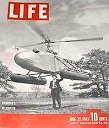 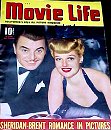

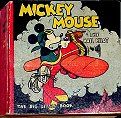 Big Little Book | |||||||||||||||||||
slang Like most things in the 1940s, many slang terms were influenced by the war. *doll dizzy --girl crazy *dilly --a cute girl *blackout girl --a cute girl *Able-Grable --a cute girl *some of Hitler's work, no doubt --an unattractive girl *void coupon --an unattractive girl *share crop --a sexually promiscuous girl *khaki wacky --boy crazy *active duty --a sexually promiscuous boy *drooly --a cute guy *greeby --terrible *ducky shincracker --a good dancer |
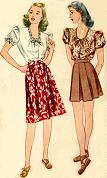
| |||||||||||||||||||
 wartime austerity In the early 1940s, everything we did was affected by the war. Visit my Life During The War page to see life on the home front and in the military during World War II. | ||||||||||||||||||||
family & faith  For a long time, the average age at which young people first got married hovered around 24 for men and 21 for women. In the 1940s, these figures took a big plunge...down to 22 for men and 20 for women. The wartime climate created a sense of uncertainty, and couples were dispensing with long courtships and tying the knot as soon as possible. After the war, everyone was eager to "get back to normal," and young people got married and settled down in record numbers, and at increasingly younger ages.  most popular baby names of 1945 most popular baby names of 1945
faith Religion was still traditional in the 1940s. Nuns were dressed in full habit, and their strict, no-nonsense attitude instilled fear in the hearts of children who attended Catholic schools. In many states, blue laws were in effect, making it illegal for stores and other establishments to conduct business on Sundays. In these areas, there was no shopping, eating out or putting gas in the car on the Lord's day. A typical Sunday consisted of attending church, followed by Sunday School. Then it was time to read the funnies, sit down to a HUGE noon meal, and then go out for a drive and maybe a picnic. The Little Brown Church In The Vale Blue Laws Catholic School Memories
|
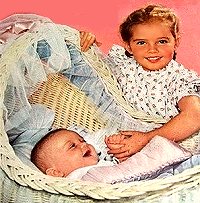 The baby boom began after the war, when young couples who had endured years of uncertainty started their families in earnest. As a result, American culture became increasingly "child centered."  "Breakfast is ready!" 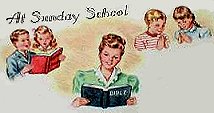
 telephones telephonesIn the 1940s, roughly 60 percent of middle-class households and nearly all upper-class households had a phone. Service was slow to arrive in rural areas, however....only 30 percent of farm homes had a phone during this decade. the central exchange office Each telephone subscriber was connected to the nearest central exchange office, which was named after the town or street where it was located. Your individual subscriber number could range from one to five digits. "number, please?" If an operator connected the calls within your exchange, you had a manual exchange. You signaled her by picking up the receiver and clicking the switchhook. Your phone didn't have a dial, because phone numbers were given to the operator verbally. When you made a call, you provided the subscriber number and party line extension. You also mentioned the central office name if there were many exchanges nearby.  long distance All out-of-town calls were placed by the operator. You gave her the city and state, the exchange or central office name, and the subscriber number. If the call was going very far, a chain of operators would be involved. To prepare for the day when direct long distance dialing would be available, operators began using area codes in 1947. party lines If you couldn't afford your own phone, you shared a party line with your neighbors. Up to 12 parties shared a single subscriber number, which was followed by a party letter (J, R, M or W), a ring code (one long, two short, etc), or a combination of both. When using a party line, you had to be careful what you said, because you never knew who was listening! automatic exchanges If you could dial local numbers yourself, you had an automatic exchange. Automatic switching boards were first used regularly in the 1920s. When your exchange converted to an automatic system, the manual switchboard was removed, party line subscribers were given their own individual numbers, and everyone was given a phone with a dial. BUtterfield 8 After conversion, automatic exchanges kept their central office names. Callers dialed the first two letters, which were capitalized. To increase the available pool of exchanges, the letters were often followed by a number. This combination of letters and numbers became known as your exchange name, and was dialed before the subscriber number. On the dial, each number was shared by three letters. Even though the exchange names were different, the actual numbers being dialed could be the same as another exchange. If the exchanges were close to each other, one of them adopted a new name When you made a call within your exchange, dialing the complete exchange name usually wasn't necessary. Out-of-town callers needed to use the full exchange name. typical phone numbers automatic exchange: -------KEnwood 237 -------HUdson 3-2700 -------DAyton 3-1000 -------PEnnsylvania 6-5000 within an automatic exchange: -------8-2345 -------33-5678 -------29-238 manual exchange: -------Majestic 237 -------Cedarville 4821 -------phone 437 party line: -------Smallville 1603-W-2 -------Bedford 236-J -------Dearborn 1547-8 Get Me PEnnsylvania 6-5000 Lettered Prefixes The Telephone EXchange Name Project Video Clip: Your New Dial Phone......(1) (2)
| 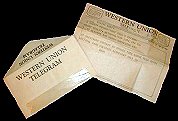 telegrams telegramsIn the 1940s, the telephone wasn't always the most efficient way to contact someone. For urgent messages, holiday greetings and long-distance communication, the telegram was still a popular alternative. To send a telegram, you either called your message in, or went to a Western Union office and filled out a blank form. In no time at all, your message was typed up, sent over telegraph lines, printed out by a machine at the receiving end, and affixed to a telegram form. It was then delivered by a uniformed Western Union employee on his trusty bicycle. Illustrated telegrams were used for holiday and birthday greetings. They were also used by tourists in place of postcards. For 25 cents, you could choose a prepared message, or for 35 cents you could compose your own message of 15 words or less. These greetings had names like Santagrams, Bunnygrams, Storkgrams and Kiddiegrams. Famous artists such as Norman Rockwell and N.C. Wyeth created lovely Christmas telegram headers. Singing telegrams, known as Sing-o-grams, were also popular. In 1945, Western Union began to replace its century-old system of poles and wires with the new technology of microwave transmission. Telegram History
| 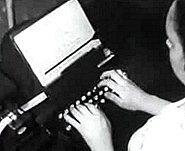 Typing the message and sending it out over telegraph lines 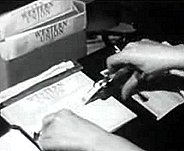 Affixing the printed message to the form 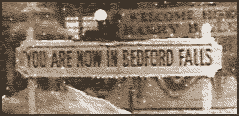 Christmas The most popular holiday during the 1940s was Christmas. Think about it: some of our favorite Christmas movies came out during this decade, and the most beloved Christmas song of all time was released in 1942...White Christmas. Beginning with the 1939 holiday season, the Montgomery Ward department store in Chicago handed out illustrated booklets featuring the story of Rudolph, The Red-Nosed Reindeer. In 1947, Johnny Marks set the story to music, and it was a major hit for Gene Autry in 1949.  The war years were a difficult period, causing many people to question their beliefs and to yearn for a simpler, happier time. Families torn apart and scattered across the globe wanted nothing more than to be HOME, and what holiday evokes the feeling of "home" more than Christmas? Thanksgiving In 1939, President Roosevelt bowed to the wishes of the nation's retailers and moved Thanksgiving from the last Thursday in November to a week earlier. This added an extra week to the Christmas shopping season. This confused and angered most Americans, and only half of the states celebrated on the new day. The same thing occurred in 1940 and 1941. By 1942, FDR had seen the error of his ways, and he signed legislation that established the fourth Thursday in November as Thanksgiving forever. The first Macy's Thanksgiving Day Parade took place in 1924. Giant helium balloons depicting popular entertainment characters were first used in 1927. During the war, the parade was cancelled, in large part because the rubber and helium used for the balloons were needed for the war effort. The parade resumed in 1945 and was first televised in 1948. The Year We Had Two Thanksgivings Macy's Thanksgiving Parade History Macy's Thanksgiving Day Parade
| 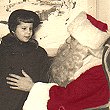 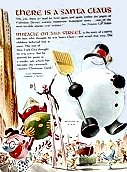
debutantes The tradition of making your debut in adult society came from England and gained popularity in America in the late 1800s. Upper-class girls of marrying age "came out" at parties and debutante balls...this was a formal announcement that she was eligible for marriage to suitable young men. In this way, young ladies were guided into the proper social circles, and well-to-do families could maintain (or raise) their social standing. In the 1940s, debutantes often performed charity work or took on special projects. In 1947, the Deb Of The Year was none other than Jacqueline Bouvier (later to become Jacqueline Kennedy Onassis). The classic "debutante look" consisted of light-colored evening gowns and above-the-elbow white gloves. Debutante Registers were published each year, featuring photos and details about the young ladies. debs of the 1940s Oona O'Neill Valerie Axtell Jacqueline Bouvier Gloria Vanderbilt
|  

| |||||||||||||||